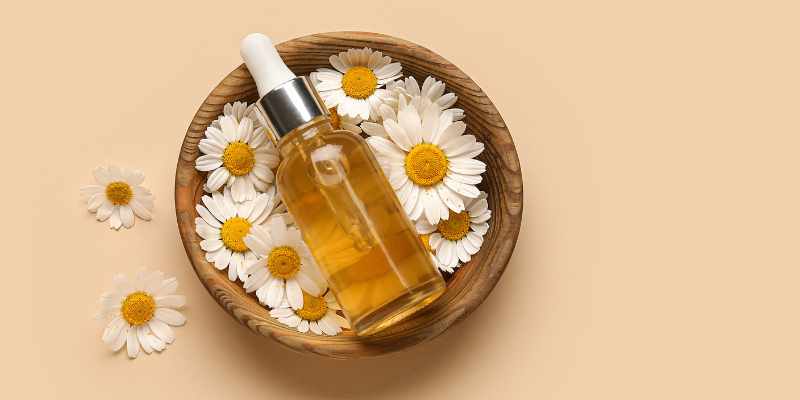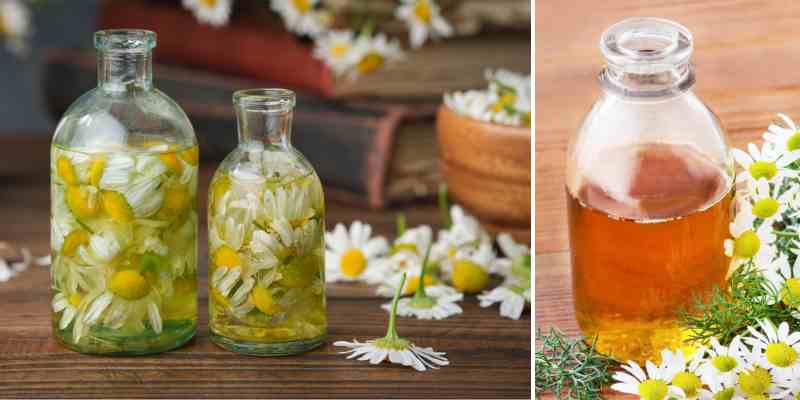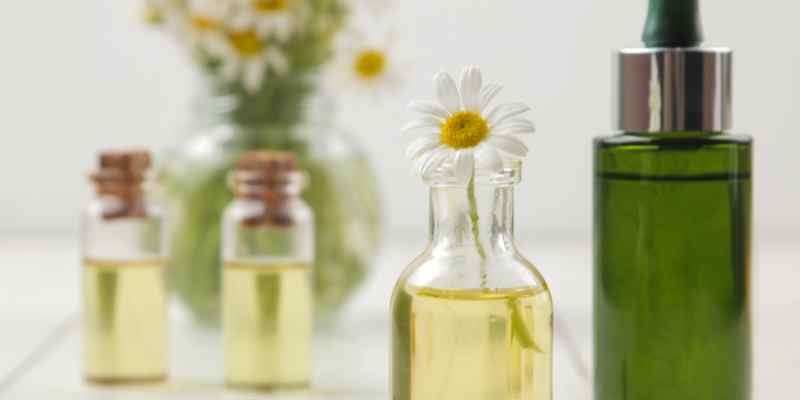Looking to care for your skin, face, and hair with a gentle, soothing, and 100% natural oil? This step-by-step tutorial guides you on how to make homemade chamomile oil, a precious ally in cosmetics. This is not about preparing an essential oil but rather a gentler and easier-to-make infusion at home. With just a few simple steps, discover how to capture the benefits of chamomile in a nourishing and soothing plant oil!

Which chamomile should you choose?
For a high-quality oil, the ideal is to grow your own chamomile in the garden and harvest the flowers at their peak bloom in summer. Once picked, the chamomile tops should be carefully dried before being used for infusion. Drying chamomile flowers is recommended to avoid moisture, which could cause the oil to go rancid. Both Roman chamomile (Chamaemelum nobile) and German chamomile (Matricaria recutita) are perfectly suited for this purpose. Both varieties are easy to grow in the ground or in pots and offer abundant flowering, ideal for homemade oil preparation.

Which plant oil should you choose?
Since this involves making a chamomile infusion, it’s important to choose a gentle, stable plant oil that complements the soothing properties of the plant. Almond oil is one of the best options: it’s very well tolerated, ideal for sensitive skin, and suitable for both body and facial care. It pairs perfectly with chamomile to calm redness, irritation, or tightness.
Jojoba oil is also an excellent choice, especially for facial use. Its light, non-greasy texture and affinity with the skin make it an ideal base for a balancing treatment, particularly if chamomile is used to soothe skin prone to inflammation or blemishes. Finally, for hair care, avocado oil nourishes hair deeply while enhancing the softening and brightening effects of the flower.
How to make homemade chamomile oil step by step ?
Equipment needed to make chamomile oil
- A clean, airtight glass jar
- Muslin or fine filter
- Dark glass bottle
Ingredients for chamomile oil
- Approximately 25 to 30 g of dried chamomile flowers (about 2 good handfuls)
- 200 to 250 ml of plant oil
Steps for the chamomile oil recipe
- Fill a clean, dry glass jar with dried chamomile flowers
- Pour the chosen plant oil until the flowers are completely covered
- Seal the jar tightly
- Place the jar in sunlight for 3 to 4 weeks, shaking it gently every day
- Filter the oil using a fine filter or muslin once the time has passed
- Transfer the oil into a dark glass bottle to protect it from light

Benefits and virtues of chamomile oil
Chamomile oil is known for its calming and anti-inflammatory properties. It soothes redness, itching, and skin irritation. On the face, it softens sensitive and reactive skin. With regular use, it contributes to a more even complexion and a feeling of skin comfort. It is also renowned for calming sunburn or sensitive areas after hair removal. For hair, in addition to nourishing and softening the hair fibre, it is known to naturally revive blonde highlights and slightly lighten light or brown hair, especially when used before moderate sun exposure, which enhances its lightening effect. It also adds shine and helps soothe sensitive scalps.
How to use chamomile oil?
This oil can be applied directly to the skin or scalp with a gentle massage. For the face, a few drops are enough as a night treatment or as a replacement for a moisturiser. It is also perfect as a base for a homemade makeup remover or to enrich a hair mask or body cream. For hair, it can be used as a pre-shampoo oil treatment. For a lightening effect, leave chamomile oil on the hair for 1 to 2 hours, preferably in natural light. The combined action of sunlight and heat enhances the effectiveness of the natural lightening compounds present in chamomile. Weekly application gradually intensifies blonde highlights, especially on light or brown hair.
How to store chamomile oil?
The oil should be stored away from light, in a dark glass bottle, preferably in a cool, dry place. It keeps for several months if the preparation conditions were followed correctly, especially if the flowers used were thoroughly dried. A slight unpleasant odour or a change in colour may indicate that it is no longer usable or has gone rancid.

Precautions and contraindications for chamomile oil
Even though homemade chamomile oil is well tolerated, a few precautions are useful. It is advisable to do a patch test on the inner elbow before the first use, especially for sensitive or reactive skin. If you have a known allergy to Asteraceae (the botanical family of chamomile), its use is not recommended. This family includes several common plants that may cause cross-reactions, such as arnica, dandelion, yarrow, daisy, or sunflower.
Since the oil is intended for external use, it should not be ingested. It does not replace medical treatment for serious skin issues. For children over three years old, it can be used in small amounts, particularly to soothe redness or dry areas, provided a patch test is done beforehand and contact with the face or eyes is avoided. Finally, for pregnant or breastfeeding women, although the oil is gentle, medical advice is always preferable before any regular use.
































Comments